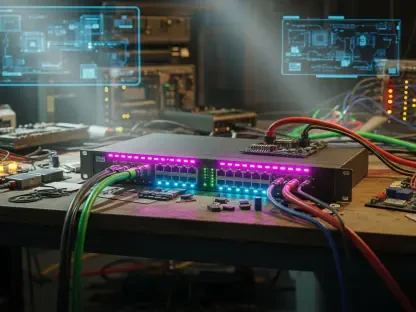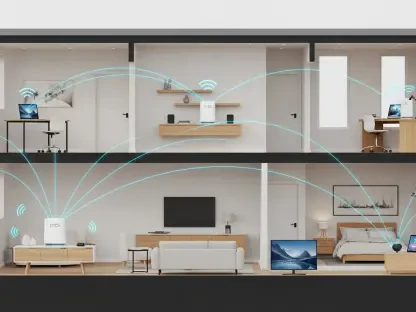Introduction to a Connected Future
The telecommunications industry stands at a pivotal moment where the infrastructure of today could redefine the cities of tomorrow. With over 5 million 5G base stations deployed globally as of this year, the sheer scale of cellular networks offers an unprecedented opportunity to transform urban landscapes. What if these towers, primarily built for communication, could also act as sensors to detect people, objects, and even subtle vibrations? This intriguing possibility, driven by the advent of 6G technology, promises to enhance safety, efficiency, and innovation in smart cities. The concept of Information and Sensing Convergence (ISAC) is at the heart of this transformation, pushing the boundaries of what cellular infrastructure can achieve. This report delves into the potential of repurposing 5G towers as 6G sensors, exploring industry trends, challenges, and the ethical considerations of such a groundbreaking shift.
The Current Landscape of Cellular Infrastructure and 5G Technology
The telecommunications sector has witnessed a rapid expansion of 5G networks, with widespread deployment across major urban centers and rural areas alike. As a cornerstone of modern connectivity, 5G technology supports faster data speeds, lower latency, and the capacity to connect millions of devices simultaneously. This infrastructure forms the backbone of digital economies, enabling everything from remote work to real-time IoT applications. The global rollout, led by significant investments from governments and private entities, underscores the strategic importance of these networks in driving technological progress.
Key industry players such as LG UPlus, Huawei, and Qualcomm have been instrumental in shaping the evolution of 5G technology. LG UPlus has pioneered innovative applications of cellular networks, while Huawei has focused on scalable hardware solutions for widespread adoption. Qualcomm, on the other hand, continues to lead in chipset development, ensuring devices and infrastructure operate seamlessly. Their collective efforts have not only accelerated 5G deployment but also laid the groundwork for future advancements, positioning cellular towers as critical assets beyond mere communication hubs.
Regulations and standards governing cellular networks remain a vital aspect of this landscape. Bodies like the International Telecommunication Union (ITU) and national regulators enforce guidelines on spectrum allocation, data security, and environmental impact. These frameworks ensure that 5G infrastructure operates within safe and equitable boundaries, balancing innovation with public interest. As the industry looks toward 6G, these regulations will need to evolve to address emerging capabilities like sensing, which could redefine the role of towers in society.
The Vision of 6G and Information and Sensing Convergence (ISAC)
Emerging Trends in Wireless Sensing
The concept of ISAC represents a revolutionary leap in telecommunications by integrating sensing capabilities into cellular infrastructure. Unlike traditional networks that rely on devices for data exchange, ISAC enables the detection of people and objects without any intermediary hardware. This device-free approach leverages radio signals to monitor environments, opening up possibilities for applications that were previously unimaginable in the realm of wireless technology.
Industry leaders have already begun exploring this frontier with notable contributions. LG UPlus has outlined ambitious plans to embed sensing into future networks, while Huawei has emphasized the role of advanced algorithms in enhancing detection accuracy for several years now. Qualcomm, in its recent projections, highlighted the potential for 6G towers to serve dual purposes as communication and sensing nodes by the end of this decade. These insights reflect a growing consensus that cellular infrastructure must evolve to meet diverse needs beyond connectivity.
Technological drivers such as higher frequency bands, improved signal processing, and artificial intelligence are accelerating the development of 6G sensing capabilities. These advancements enable precise environmental mapping, which could benefit urban planning and industrial automation. The trend toward integrating sensing into towers signals a shift in how telecommunications can address real-world challenges, from disaster response to infrastructure monitoring, creating a robust ecosystem of interconnected solutions.
Potential Impact and Growth Projections
The integration of ISAC into 6G networks holds transformative potential for smarter cities by enhancing public safety and operational efficiency. Imagine urban areas where towers detect pedestrian and vehicular movement in real time, reducing accidents at busy intersections. Such technology could also optimize traffic flow by identifying congestion patterns, providing data to city planners for better infrastructure design. Additionally, autonomous vehicles could rely on these sensors to navigate complex environments, complementing onboard systems with external data.
Industrial applications of ISAC are equally promising, particularly in predictive maintenance. By sensing subtle vibrations in machinery, 6G-enabled towers could alert operators to potential failures before they occur, minimizing downtime and repair costs. This capability would be invaluable in sectors like manufacturing and logistics, where equipment reliability is paramount. The ability to monitor assets remotely through existing infrastructure offers a scalable solution for industries seeking to modernize operations.
Looking ahead, repurposing 5G towers for 6G sensing appears cost-effective, as it leverages existing structures rather than requiring new builds. Analysts project that retrofitting current infrastructure could reduce deployment expenses by up to 30% compared to standalone sensor networks over the next five years. This economic advantage, combined with the scalability of cellular networks, positions ISAC as a viable pathway for widespread adoption, provided technical and regulatory hurdles are addressed.
Challenges in Repurposing 5G Towers for Sensing
Adapting 5G towers for ISAC under a 6G framework presents significant technical obstacles that must be overcome. Current infrastructure is optimized for data transmission, not environmental sensing, requiring upgrades in hardware and software to handle dual functionalities. Higher frequency bands used in 6G also face limitations in penetration and range, necessitating innovative solutions to ensure reliable detection across diverse terrains and urban densities.
Market-driven challenges further complicate this transition, particularly around public acceptance and industry collaboration. The notion of towers continuously monitoring environments may evoke skepticism among communities wary of surveillance. Convincing stakeholders of the benefits while addressing these concerns demands transparent communication and trust-building measures. Moreover, achieving industry-wide standards for ISAC integration requires cooperation among tech giants, smaller firms, and regulatory bodies—a process that could face delays due to competing interests.
Potential solutions lie in phased integration and strategic partnerships to ease the shift. Gradual upgrades to towers, starting with pilot projects in select cities, could demonstrate feasibility and build momentum for broader rollout. Collaborations between technology providers and municipal authorities might also streamline deployment, ensuring that sensing applications align with urban needs. These approaches could mitigate both technical and societal barriers, paving the way for a smoother evolution of cellular infrastructure.
Privacy and Ethical Concerns in a Sensing-Driven Era
The rise of ISAC technology brings with it a complex regulatory landscape surrounding data privacy and surveillance in telecommunications. Existing laws, such as the General Data Protection Regulation (GDPR) in Europe and various national frameworks, emphasize user consent and data minimization. However, the device-free nature of ISAC challenges these principles, as individuals may be tracked without explicit interaction or awareness, raising questions about compliance with current standards.
Ethical implications of continuous monitoring are profound, particularly concerning personal autonomy. The ability of towers to detect presence and movement without opt-out mechanisms could be perceived as intrusive, even if intended for benign purposes like safety. Public discourse on balancing technological benefits with individual rights must address fears of misuse, ensuring that sensing capabilities do not erode trust in digital infrastructure. This tension highlights the need for clear boundaries on data collection and usage.
Robust policies and compliance measures are essential to mitigate these concerns and protect societal values. Developing frameworks that mandate transparency in how sensing data is gathered and processed could foster accountability. Industry stakeholders must also engage with communities to understand apprehensions and incorporate feedback into technology design. Only through such proactive steps can the telecommunications sector navigate the ethical minefield of a sensing-driven future.
The Future of Cellular Towers in the 6G Era
Cellular towers are poised to become multifunctional assets in the 6G era, evolving from communication nodes to integral components of smart ecosystems. Their potential as sensors could redefine urban and industrial landscapes by enabling real-time data collection on an unprecedented scale. This dual role promises to maximize the utility of existing infrastructure, aligning with global goals for sustainable and efficient technology deployment.
Emerging innovations, such as advanced beamforming and machine learning algorithms, are set to further enhance the capabilities of 6G towers. These disruptors could improve the precision of sensing applications, from environmental monitoring to crowd management during large events. As smart city initiatives gain traction worldwide, the integration of such technologies into cellular networks will likely become a priority for policymakers and urban planners seeking data-driven solutions.
Global economic conditions, shifting consumer expectations, and regulatory changes will undoubtedly influence this transition. Economic downturns might slow investment in 6G upgrades, while heightened demand for privacy could push for stricter oversight of sensing technologies. Navigating these dynamics will require agility from industry leaders to adapt to varying regional priorities. The path forward for cellular towers hinges on balancing innovation with responsiveness to societal and market trends.
Reflecting on a Path Forward
Looking back, the exploration of repurposing 5G towers as 6G sensors revealed a landscape brimming with potential yet fraught with challenges. The transformative promise of ISAC stood out as a catalyst for safer, more efficient urban and industrial environments, but privacy and technical hurdles underscored the complexity of this shift. The discussions highlighted how industry collaboration and regulatory foresight emerged as critical factors in shaping this evolution.
Moving ahead, actionable steps became clear for stakeholders across the spectrum. Technology providers should prioritize developing scalable, privacy-conscious sensing solutions, while policymakers must craft guidelines that safeguard individual rights without stifling innovation. Partnerships between cities and private entities could serve as testbeds for pilot programs, building evidence of benefits to win public support. These efforts, grounded in transparency and ethical considerations, offer a roadmap to harness the power of 6G sensing responsibly.
Ultimately, the journey reflected a broader imperative to align technological progress with societal good. Future considerations should focus on fostering dialogue among communities, governments, and industries to ensure that the benefits of smarter cities do not come at the cost of trust. By addressing these priorities, the telecommunications sector can lead the charge in creating a connected world that values both innovation and humanity.









